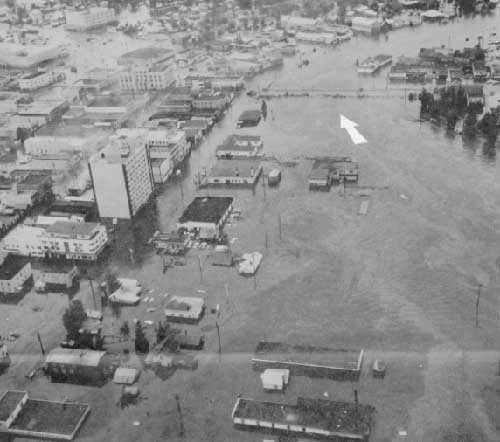 A Celebrating State Holds Its Breath By June Allen August 07, 2003
Back in late June of 1905, after a tardy breakup of Alaska's frozen rivers, the supports of the new city's one bridge had collected great mounds of ice chunks and drift debris that plugged the river and sent the surging backed-up waters spilling over the river's bank and into the downtown area. In desperation the city fathers chose to dynamite the bridge, solving the immediate problem, but leaving the two sides of Fairbanks isolated one from the other. Live and learn. A couple of years later the same thing happened again, but this time the builder of the bridge sat on it, his arms folded across his chest, defying the city fathers to dynamite the bridge until they paid him for the structure's construction! They paid, and then blew it up. The Chena is a mild-mannered river that divides the north from the south neighborhoods of Fairbanks, a river usually slow to sluggish in summer and mushy to frozen in winter. With a warm weather depth of about five or six feet - maybe almost halfway or so up its banks, the grayish-brown river moseys through town like a small boy slowly scuffing along a country road. With a little extra rainfall the stream might kick along a few sticks and shiny gray branches as it goes. The Chena on its journey toward the west will soon spill its cargo of water into the broad and braided Tanana River, an immense and lengthy stream that explores broad reaches of Alaska's Interior en route to its own confluence with the mighty Yukon en route to the sea. The runways of Fairbanks International Airport five miles or so west of the city parallel the Tanana River. Although the Chena River is comparatively shallow, it is still deep enough today for its famous stern-wheeler riverboat Discovery III to paddle delighted tourists on tours along the river, past Native Alaskan fish wheels, log cabins and waving riverside residents. And it was deep enough back in 1902 to allow another now-famous sternwheeler, the Lavelle Young, to make it just far enough up the river to allow it its skipper to offload $20,000 of trading goods and trader E.T. Barnette - and then turn around and head back out toward the Tanana River again. Barnette had intended to travel much farther inland, but he found himself and his goods stranded in the middle of nowhere. Then again out of nowhere, a lucky prospector who had just struck it rich in the hills to the north happened to see the smoke of the departing sternwheeler and hiked down to see what was there. And thus Fairbanks Alaska was born.  [between ca. 1900 and ca. 1916] Forms part of: Frank and Frances Carpenter collection Gift; Mrs. W. Chapin Huntington; 1951. Photo Courtesy Library of Congress By 1967 Fairbanks had grown from those first two newcomers to a city of 30,000 whose residents were celebrating the Alaska Centennial of the Alaska Purchase from Russia a century earlier, while the river was rising inch by inch. During that second week of August, official Fairbanks radio and TV reports barked flood warnings, announcing an impending crest. When the river's level didn't match either the official or the amateur eyeball estimates of river-watchers, Fairbanksans shrugged and went about their business. There are those still today who say that too many warnings defeated their purpose and were eventually largely ignored. But then on August 15 the waters of the Chena did indeed spill over the river's banks and rush into the city, into homes and businesses, pouring in to destroy basement furnaces, appliances and storage, creeping up to first floors, soaking flooring, furniture and precious belongings, ruining forever essential legal papers, family photos and shoe boxes filled with snapshots. Utilities were out. There was danger on every side, including disease. This was not a sparkling wilderness flood-lake but a deep sludgy pond of suddenly visible sewage, garbage and muddy and unidentifiable lost property. Some of the inventory of J.C. Penney's and other downtown business floated like muddy rafts past homes in the neighborhoods west of the downtown area. All highway connections were out, and commercial air traffic was stopped by the Alaska Disaster Office. Fairbanks mayor Red Boucher called Gov. Wally Hickel on the town's only open phone line. In Washington D.C., Alaska Sen. Bob Bartlett said he received a call from the governor who told him the Fairbanks flood was a major disaster. The damage was later reported to exceed $200 million (in 1967 dollars). Newspapers all over Alaska carried front page stories of the Fairbanks flood. What happens in one town in Alaska impacts every Alaskan. Interior Alaska sport fishermen and hunters favor long, flat-bottomed riverboats for wilderness recreation, and these vessels joined other small craft in rescue operations, skimming through neighborhoods, checking on residents and pets. Yellow Cab owner Rod Moore, familiar after many years with every neighborhood, street and alley in or near Fairbanks, was ferried over suddenly strangely unfamiliar submerged neighborhoods to point out landmarks and to identify locations. Mayor Boucher, the mayor's friend William Randolph Hearst, and other officials toured afloat through the watery neighborhoods too. Seattle Times veteran Alaska news reporter Stanton Patty, covering the flood, said that in the solemnity of the search operations the mayor, standing in the bow, looked for all the world like George Washington crossing the Delaware. There were memorable moments. Many of the downtown people took refuge in the upper floors of the eight-story Northward Building, the metal-clad 1954 "skyscraper" that was featured as the Ice Palace in Edna Ferber's novel of the same name. The 1958 novel was written as a political boost in favor of Alaska Statehood, which was granted by the U.S. Congress just a year later. Reviewers called the huge novel "the Uncle Tom's Cabin of the Alaska statehood movement"! Alaska's Territorial governor of that era, Ernest Gruening, was a friend of the famous Ferber and advised her as she wrote the book. Oldtimers from Southeastern's Petersburg to Fairbanks to the Arctic's Kotzebue can tell you on which barstools the movie's stars sat - especially the respected but handsome and hard drinking actor Richard Burton - while making the movie Ice Palace.  Photo courtesy USGS Those Fairbanks flood victims who fled into the Northward Building crowded into the small apartments on the upper floors, the real occupants generously sharing their quarters. Much of the stock of the first-floor Northward Bar was salvaged and provided warmth and cheer for the refugees. Women pooled food and cooked meals for the crowd while others moved from floor to floor like occupants of a sorority/fraternity house, as one survivor said. Stranded residents in other parts of the city were taken to the University of Alaska, situated on College Hill west of town and to other places where a little elevation kept buildings dry. People who had crowded into shelter quarters later reported that they shared stories, talked about their flooded homes, cars and businesses and often just sat in a stupor, unable to believe what had happened and wondering what came next. At first, no lives were reported lost, injuries were few, but the gravity of situation was evident. As some sort of order was restored, later reports mentioned seven dead from the widespread flooding. Six inches of rain had fallen in the five days before the river crested and spilled over at 18.6 feet. It was a serious situation that would take a good long time to remedy. At the moment, however, there were pressing problems of feeding people, providing basic necessities, sanitation, diapers, vaccinations, cleanup, and planning for recovery. It hadn't taken as long as it probably seemed for the river to go down again. The town was almost overwhelmed. Old log cabins that had been the treasures of the city since its earliest days, some of them in the same city blocks with modern buildings, suffered severe damage. People dreaded going to inspect their properties. Basement furnaces, many of them coal-fired with the coal from the Usibelli fields along the Alaska Railroad route to the south, were converted to oil. A massive cleanup was initiated to rid the city of soggy and ruined carpets, overstuffed furniture and many other things forever lost, overwhelming garbage collections. And it was almost time for school to open, with so much that had to be done first. As happens in Fairbanks, Alaska, freezeup in the fall can be a blessing or a curse - or sometimes both. As the city worked furiously to get ready for winter - which can be bitterly cold in that latitude - the first snowfall hid much of the damage. In earlier days Fairbanksans used to joke that when it started snowing in the fall there'd be a one-beer-can snowfall, or maybe it would be a heavier two-beer-can snowfall that would cover the ground up to two-beer-can depth. The year 1967 had been the observance and celebration of the Alaska Purchase Centennial. Federal and state monies had been available to the state's cities for appropriate memorial projects. Fairbanks had earlier chosen to create a Pioneer Park near the west edge of town on the bank of the Chena, a large parcel that would include a pioneer museum, a theater-gallery building shaped a little like a birthday cake, picnic grounds, and a "gold mining town" of old dredging apparatus and other mining equipment and memorabilia. Plans were then expanded to include a "pioneer town," and those wonderful old log cabins damaged in the flood were carefully moved to the park to create a street of such cabins, along with an old log hotel and small church. The park was later renamed Alaskaland - but it was recently changed back to Pioneer Park. Today the Fairbanks Flood of '67 is largely forgotten or at least not usually one of the tales of derring-do that Fairbanksans love to share. But it's raining in Fairbanks this summer, and the river has risen a little.
june@sitnews.org
All rights reserved. Not to be reprinted in any form without the written permission of June Allen.
|
||||||||






